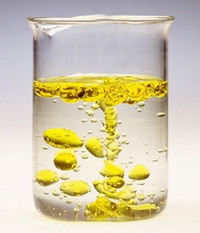Difference between Homogeneous and Heterogeneous
Key Difference: Homogenous refers to a solution that is a completely uniform mixture of two or more objects. Heterogeneous refers to solutions that are not completely uniform and in most cases is clearly visible when viewing the mixture.
 The terms ‘homogeneous’ and ‘heterogeneous’ are commonly used words in chemistry and refer to solutions and mixtures. Any type of mixture can be divided as homogenous or heterogeneous. Because of the similarity of the terms, both are often confusing for many people just understanding the differences.
The terms ‘homogeneous’ and ‘heterogeneous’ are commonly used words in chemistry and refer to solutions and mixtures. Any type of mixture can be divided as homogenous or heterogeneous. Because of the similarity of the terms, both are often confusing for many people just understanding the differences.
Homogenous refers to a solution that is completely uniform mixture of two or more objects. In a homogenous mixture, all of the objects mix to the point that it is difficult to distinguish one from the other. The main characteristic of a homogenous mixture is that if a mixture is divided in half, then there would be equal amounts of all of the substances that have been added. For example: if water and salt are mixed together and then divided in two glasses, each glass would have the same amount of material in both glasses. Metals, alloys, ceramics and plastics all fall into a homogeneous category of materials. Homogenous mixtures are considered as solutions. Once a solution is created, it cannot be separated by mechanical methods but rather only chemical ones. Examples of homogenous mixtures include air, blood, water, water and sugar.
Merriam Webster defines ‘homogeneous’ as:
- of the same or a similar kind or nature.
- of uniform structure or composition throughout.
- having the property that if each variable is replaced by a constant times that variable the constant can be factored out.
 Heterogeneous refers to solutions that are not completely uniform and in many cases is clearly visible when viewing the mixture. In a heterogeneous mixture, although all the components are mixed into a same container, it does not necessarily mean that they would mix to the point that they resemble one whole solution. Materials used in a heterogeneous mixture have different structures and compositions than each other. However, in some cases the different components may seem completely mixed to the naked eye but the different components could be visible under a microscope. Also, if a heterogeneous mixture was divided into two, there would be uneven amount of all the substances. Examples of heterogeneous mixtures include sand and water, water and oil and rocks. If water and sand were placed in one container, the sand would sink to the bottom. Now, if this mix was separated into a second container, there would be more water and less sand.
Heterogeneous refers to solutions that are not completely uniform and in many cases is clearly visible when viewing the mixture. In a heterogeneous mixture, although all the components are mixed into a same container, it does not necessarily mean that they would mix to the point that they resemble one whole solution. Materials used in a heterogeneous mixture have different structures and compositions than each other. However, in some cases the different components may seem completely mixed to the naked eye but the different components could be visible under a microscope. Also, if a heterogeneous mixture was divided into two, there would be uneven amount of all the substances. Examples of heterogeneous mixtures include sand and water, water and oil and rocks. If water and sand were placed in one container, the sand would sink to the bottom. Now, if this mix was separated into a second container, there would be more water and less sand.
‘Heterogeneous’ is defined as:
- consisting of dissimilar or diverse ingredients or constituents.
Homogeneous and heterogeneous are actually complete opposite of each other. Homogeneous mixtures refer to a solution that mixes to the point that it becomes hard to distinguish each separate component. However, in a heterogeneous mixture, the components do not mix together but instead are just in the same container. Another major difference is that a homogeneous mixture cannot be separated using mechanical means, while most heterogeneous mixtures can be separated.
Image Courtesy: education.com, sritweets.com









Comments
This answers really helped a lot.tanks alot
g-donzzy
Wed, 08/13/2014 - 01:55
Add new comment